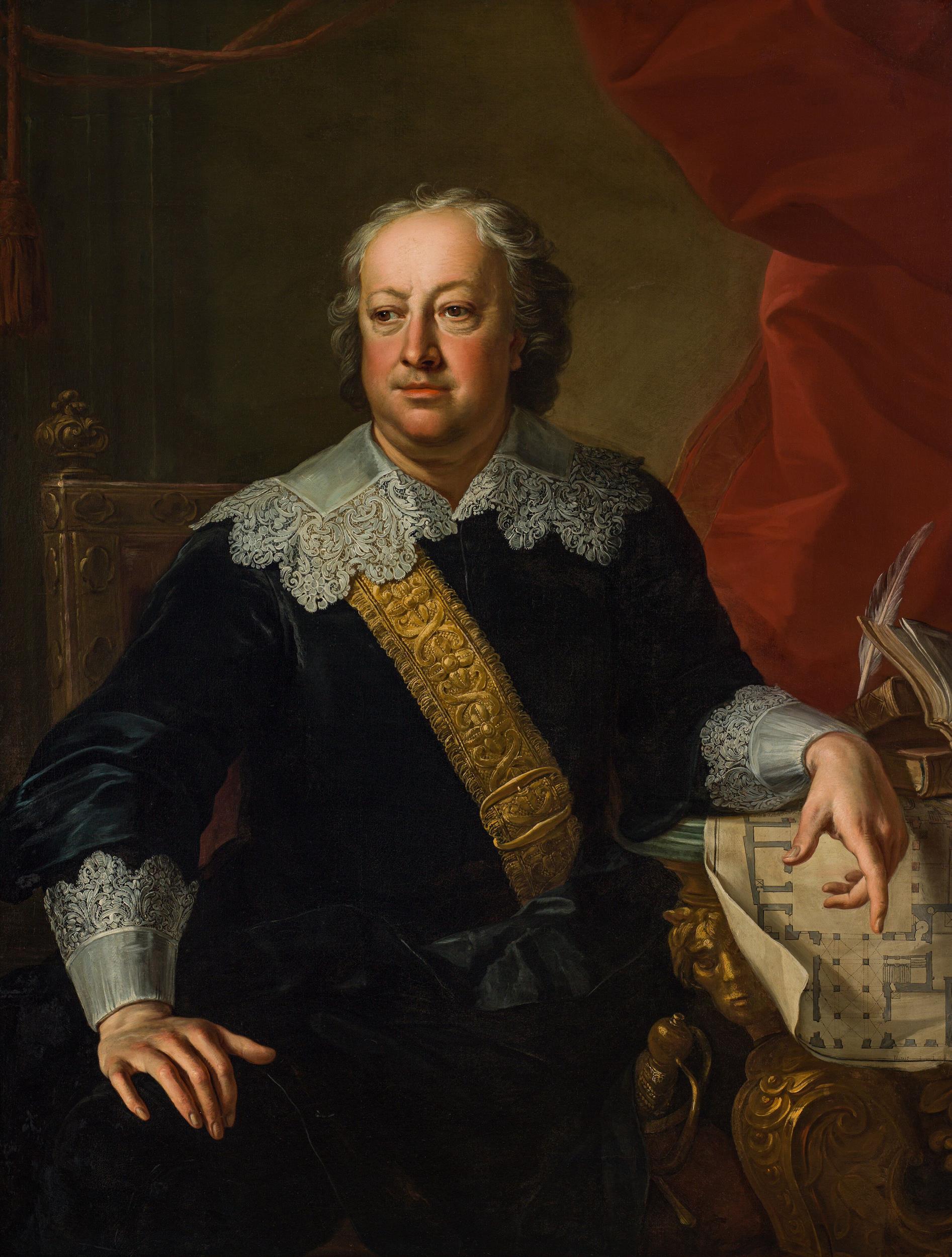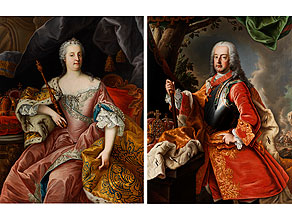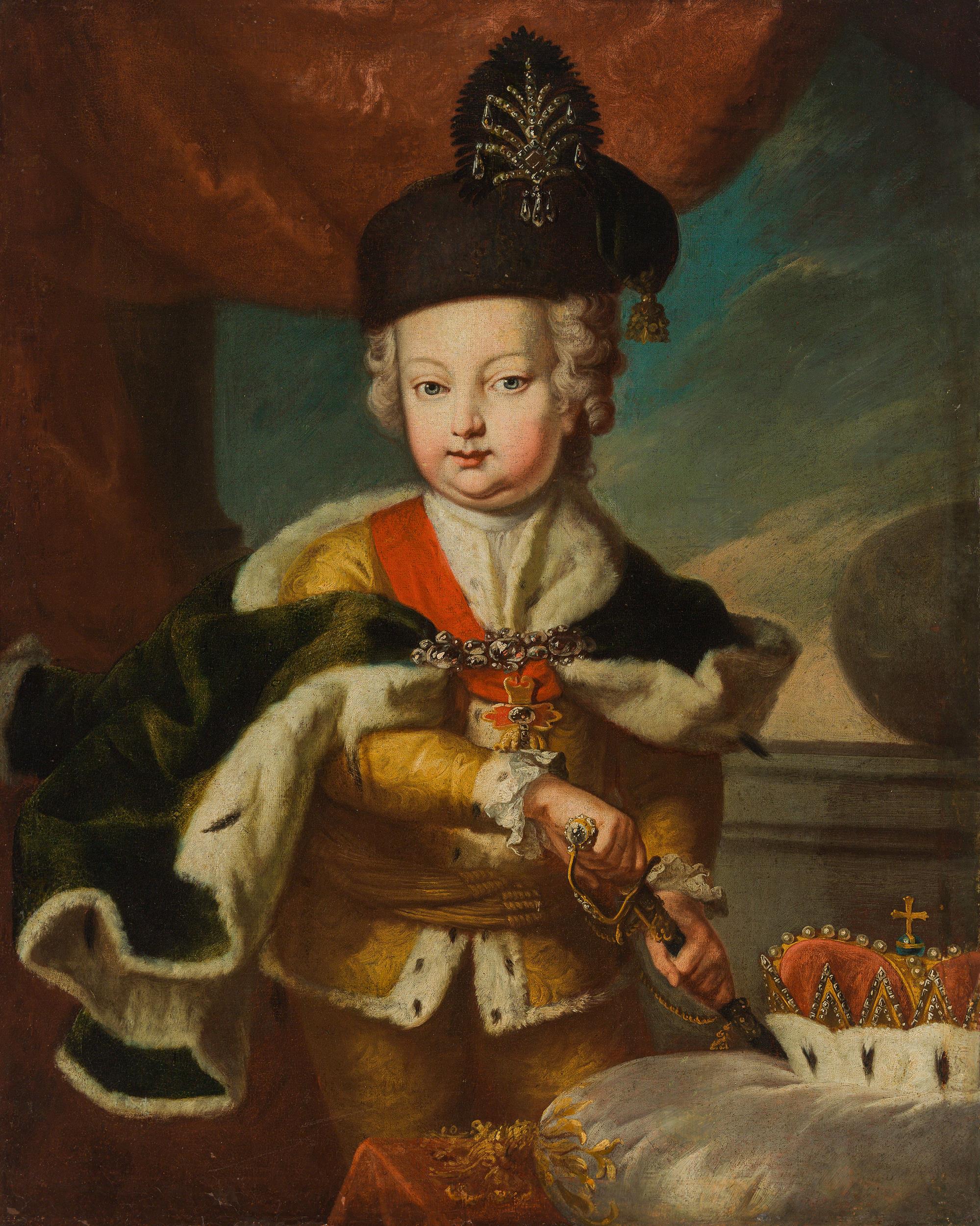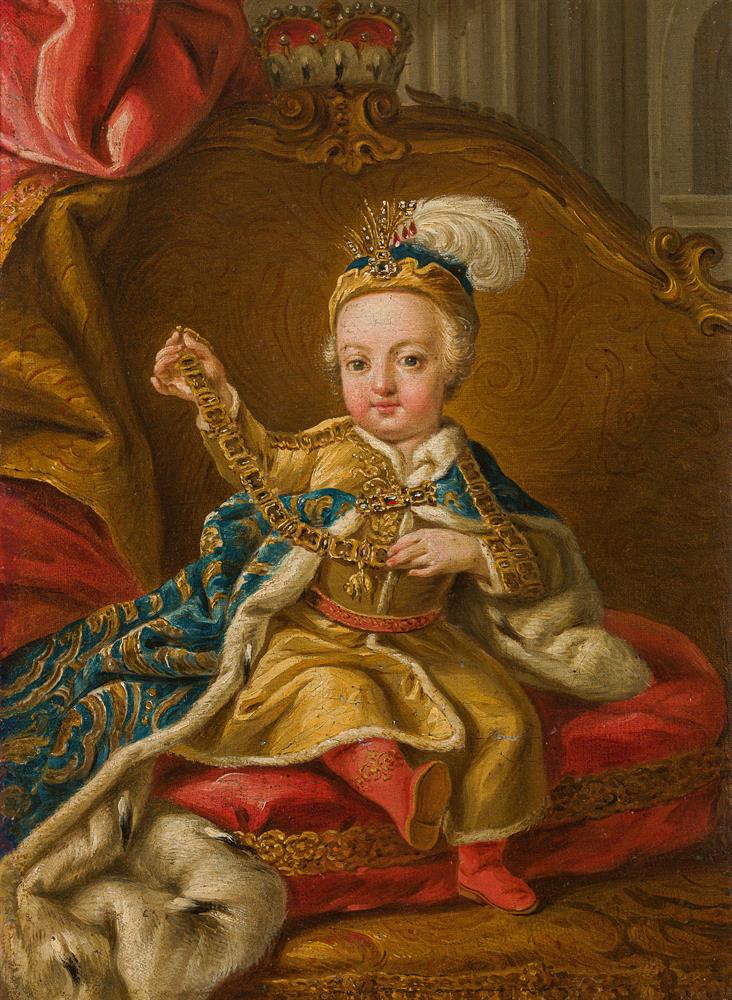Meytens, Martin van d.J. Schule
1695 Stockholm - 1770 Wien.
Porträt Kaiser Franz I. Stephan.
Öl auf Leinwand, doubliert. Unsign. Verso auf dem Keilrahmen auf einem Etikett handschriftlich bez. «Bildnis von Franz I. Deutscher Kaiser. Franz Stephan aus dem Hause Lothringen, Gemahl Maria Theresias gemalt von Martijn van Meytens d.J. ca. anno 1755 Kaiserlicher Kammermaler zu Wien Restauriert von Maler Woldemar Kohlund, München 1962-63».
H. 150, B. 118 cm (Bildträger). Originaler Prunkrahmen.
Franz I. Stephan von Lothringen (1708 - 1765), Kaiser des Heiligen Römischen Reiches, ist in einem prunkvollen mit Goldfäden bestickten Hofgewand mit weißen, wohl Brabanter Spitzen dargestellt. Ein Teil der Last seines Mantels ruht auf einem Thron hinter ihm, während vor ihm auf einem Tisch die hochmittelalterliche Reichskrone, ein Reichsapfel sowie eine weitere, nicht genauer zu identifizierende Krone liegen. Diese Machtsymbole legitimieren seinen vielseitig in Frage gestellten Herrschaftsanspruch. Mit programmatischen Porträts wie diesen konnten Adlige in den Provinzen des Reiches, wie die Landvögte der Ortenau aus dem Hause von Neveu, ihrer Loyalität zum Haus Habsburg Ausdruck verleihen. Der Mode der Zeit entsprechend und wie es einem Kaiser gebührt, trägt er eine Allongeperücke und einen Hut mit gefärbten Straußenfedern. Der Orden vom Goldenen Vlies auf seiner Brust ist der Hausorden der Habsburger und verweist auf seine Einheirat in das österreichische Erzhaus. Franz Stephan und Maria Theresia begründeten die Linie Habsburg-Lothringen.
Dieses monumentale Staatsporträt ist in einen vollständig vergoldeten, prachtvollen Holzrahmen eingefügt, der im blühenden süddeutschen Rokokostil gehalten ist und dessen typische Ornamentik dynamische Wellenkämme, verschlungene C-Bögen, naturalistische Blütenranken, aufgeplatzte Granatäpfel und ein Doppeladlerwappen aufweist.
Als Pendant ist das Porträt seiner Gattin Maria Theresia von Österreich konzipiert (Los 3223).
Stellungnahme: Wir danken Herrn Dr. Georg Lechner, Kurator der Sammlung Barock, Österreichische Galerie Belvedere, Wien, für die wissenschaftliche Beratung via E-Mail, anhand von Photos, 04.02.2021.
Wir danken Herrn Prof. Dr. Marcus Köhler, Technische Universität Dresden, für die freundlichen Hinweise via E-Mail, anhand von Photos, 08.09.2021.
Provenienz: Privatbesitz der Familie von Neveu, Durbach.
Zustandsbericht:
Guter rest. Gesamteindruck. Starke sowie partiell sehr starke Frühschwundrisse mit daraus resultierenden kl. Farbverlusten, Bildträger leicht brüchig, zahlreiche punktuelle fachmännische Retuschen.
Meytens, Martin van the Younger school
1695 Stockholm - 1770 Vienna.
Portrait emperor Francis I.
Oil on canvas, relined. Unsigned. Verso on the stretcher on a label handwritten inscribed «Bildnis von Franz I. Deutscher Kaiser. Franz Stephan aus dem Hause Lothringen, Gemahl Maria Theresias gemalt von Martijn van Meytens d.J. ca. anno 1755 Kaiserlicher Kammermaler zu Wien Restauriert von Maler Woldemar Kohlund, München 1962-63 (portrait of Francis I German Emperor. Francis Stephen from the House of Lorraine, husband of Maria Theresa painted by Martijn van Meytens the Younger circa anno 1755 imperial court painter at Vienna Restored by painter Woldemar Kohlund, Munich 1962-63)».
H 150, W 118 cm (support). Original elaborate frame.
Francis I Stephen of Lorraine (1708 - 1765), Holy Roman Emperor, is depicted in a magnificent court robe embroidered with gold thread and white, probably Brabant lace. Part of the weight of his cloak rests on a throne behind him, while the high medieval Imperial Crown, an imperial orb and another crown that cannot be identified more precisely are on a table in front of him. These symbols of power legitimised his claim to rule, which was questioned in many ways. With programmatic portraits such as these, nobles in the provinces of the empire, such as the governors of Ortenau from the House of Neveu, could express their loyalty to the House of Habsburg. According to the fashion of the time and as befits an emperor, he wears an allonge wig and a hat with dyed ostrich feathers. The Order of the Golden Fleece on his chest is the House Order of the Habsburg and refers to his marriage into the Austrian archhouse. Franz Stephan and Maria Theresa founded the Habsburg-Lorraine line.
This monumental state portrait is set in a fully gilded, magnificent wooden frame, which is in the flourishing South German Rococo style and whose typical ornamentation features dynamic wavy crests, intertwined C-arches, naturalistic floral tendrils, burst pomegranates, and a double-headed eagle emblem.
The portrait of his wife Maria Theresa of Austria is conceived as a counterpart (lot 3223).
Statement: We would like to thank Dr. Georg Lechner, curator of the Baroque collection, Österreichische Galerie Belvedere, Vienna, for the scientific consultation via E-Mail, based on photos, 04.02.2021.
We would like to thank Prof. Dr. Marcus Köhler, Technische Universität Dresden, for the kind remarks via E-Mail, based on photos, 08.09.2021.
Provenance: private property of the family of Neveu, Durbach.
Condition report:
Good restored overall impression. Considerable as well as partially very considerable white shrinking cracks with resulting small spots of paint loss, support slightly brittle, numerous skilfully retouched spots.
Meytens, Martin van d.J. Schule
1695 Stockholm - 1770 Wien.
Porträt Kaiser Franz I. Stephan.
Öl auf Leinwand, doubliert. Unsign. Verso auf dem Keilrahmen auf einem Etikett handschriftlich bez. «Bildnis von Franz I. Deutscher Kaiser. Franz Stephan aus dem Hause Lothringen, Gemahl Maria Theresias gemalt von Martijn van Meytens d.J. ca. anno 1755 Kaiserlicher Kammermaler zu Wien Restauriert von Maler Woldemar Kohlund, München 1962-63».
H. 150, B. 118 cm (Bildträger). Originaler Prunkrahmen.
Franz I. Stephan von Lothringen (1708 - 1765), Kaiser des Heiligen Römischen Reiches, ist in einem prunkvollen mit Goldfäden bestickten Hofgewand mit weißen, wohl Brabanter Spitzen dargestellt. Ein Teil der Last seines Mantels ruht auf einem Thron hinter ihm, während vor ihm auf einem Tisch die hochmittelalterliche Reichskrone, ein Reichsapfel sowie eine weitere, nicht genauer zu identifizierende Krone liegen. Diese Machtsymbole legitimieren seinen vielseitig in Frage gestellten Herrschaftsanspruch. Mit programmatischen Porträts wie diesen konnten Adlige in den Provinzen des Reiches, wie die Landvögte der Ortenau aus dem Hause von Neveu, ihrer Loyalität zum Haus Habsburg Ausdruck verleihen. Der Mode der Zeit entsprechend und wie es einem Kaiser gebührt, trägt er eine Allongeperücke und einen Hut mit gefärbten Straußenfedern. Der Orden vom Goldenen Vlies auf seiner Brust ist der Hausorden der Habsburger und verweist auf seine Einheirat in das österreichische Erzhaus. Franz Stephan und Maria Theresia begründeten die Linie Habsburg-Lothringen.
Dieses monumentale Staatsporträt ist in einen vollständig vergoldeten, prachtvollen Holzrahmen eingefügt, der im blühenden süddeutschen Rokokostil gehalten ist und dessen typische Ornamentik dynamische Wellenkämme, verschlungene C-Bögen, naturalistische Blütenranken, aufgeplatzte Granatäpfel und ein Doppeladlerwappen aufweist.
Als Pendant ist das Porträt seiner Gattin Maria Theresia von Österreich konzipiert (Los 3223).
Stellungnahme: Wir danken Herrn Dr. Georg Lechner, Kurator der Sammlung Barock, Österreichische Galerie Belvedere, Wien, für die wissenschaftliche Beratung via E-Mail, anhand von Photos, 04.02.2021.
Wir danken Herrn Prof. Dr. Marcus Köhler, Technische Universität Dresden, für die freundlichen Hinweise via E-Mail, anhand von Photos, 08.09.2021.
Provenienz: Privatbesitz der Familie von Neveu, Durbach.
Zustandsbericht:
Guter rest. Gesamteindruck. Starke sowie partiell sehr starke Frühschwundrisse mit daraus resultierenden kl. Farbverlusten, Bildträger leicht brüchig, zahlreiche punktuelle fachmännische Retuschen.
Meytens, Martin van the Younger school
1695 Stockholm - 1770 Vienna.
Portrait emperor Francis I.
Oil on canvas, relined. Unsigned. Verso on the stretcher on a label handwritten inscribed «Bildnis von Franz I. Deutscher Kaiser. Franz Stephan aus dem Hause Lothringen, Gemahl Maria Theresias gemalt von Martijn van Meytens d.J. ca. anno 1755 Kaiserlicher Kammermaler zu Wien Restauriert von Maler Woldemar Kohlund, München 1962-63 (portrait of Francis I German Emperor. Francis Stephen from the House of Lorraine, husband of Maria Theresa painted by Martijn van Meytens the Younger circa anno 1755 imperial court painter at Vienna Restored by painter Woldemar Kohlund, Munich 1962-63)».
H 150, W 118 cm (support). Original elaborate frame.
Francis I Stephen of Lorraine (1708 - 1765), Holy Roman Emperor, is depicted in a magnificent court robe embroidered with gold thread and white, probably Brabant lace. Part of the weight of his cloak rests on a throne behind him, while the high medieval Imperial Crown, an imperial orb and another crown that cannot be identified more precisely are on a table in front of him. These symbols of power legitimised his claim to rule, which was questioned in many ways. With programmatic portraits such as these, nobles in the provinces of the empire, such as the governors of Ortenau from the House of Neveu, could express their loyalty to the House of Habsburg. According to the fashion of the time and as befits an emperor, he wears an allonge wig and a hat with dyed ostrich feathers. The Order of the Golden Fleece on his chest is the House Order of the Habsburg and refers to his marriage into the Austrian archhouse. Franz Stephan and Maria Theresa founded the Habsburg-Lorraine line.
This monumental state portrait is set in a fully gilded, magnificent wooden frame, which is in the flourishing South German Rococo style and whose typical ornamentation features dynamic wavy crests, intertwined C-arches, naturalistic floral tendrils, burst pomegranates, and a double-headed eagle emblem.
The portrait of his wife Maria Theresa of Austria is conceived as a counterpart (lot 3223).
Statement: We would like to thank Dr. Georg Lechner, curator of the Baroque collection, Österreichische Galerie Belvedere, Vienna, for the scientific consultation via E-Mail, based on photos, 04.02.2021.
We would like to thank Prof. Dr. Marcus Köhler, Technische Universität Dresden, for the kind remarks via E-Mail, based on photos, 08.09.2021.
Provenance: private property of the family of Neveu, Durbach.
Condition report:
Good restored overall impression. Considerable as well as partially very considerable white shrinking cracks with resulting small spots of paint loss, support slightly brittle, numerous skilfully retouched spots.















Try LotSearch and its premium features for 7 days - without any costs!
Be notified automatically about new items in upcoming auctions.
Create an alert